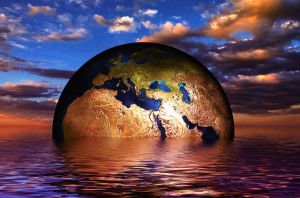Environmental Hazards: Five Challenges of Writing Climate Fiction (Part 1)
Climate fiction, like the global average temperature, is on the rise. If you haven’t heard of this genre, you’re probably not the first. Themes of climate change and ecological disaster have appeared in contemporary fiction since the mid-20th century, but the concept of these as an independent genre is relatively new. The term climate fiction appeared in 2007, usually attributed to journalist Dan Bloom, but took some time to catch on. Not until 2013 did “cli-fi” earn some mainstream attention, featuring in articles from NPR and The Guardian.
An increasing number of books are venturing into cli-fi’s semi-dystopian territory. A few I would categorize as such include Oryx and Crake by Margaret Atwood (who, incidentally, endorsed the term cli-fi in 2010) The Drowned Cities by Paolo Bacigialupi, and my own debut novel, Blue Karma. More than just fantastical entertainment, I believe cli-fi can raise public awareness of a critical issue, much as Upton Sinclair’s The Jungle exposed conditions in the meat-packing industry, or Charles Dickens’ work addressed child labor in industrial England. Our stories reflect our society, and the expansion of cli-fi evidences growing concern for our planet’s future.
*Update, 5 June 2015: Dan Bloom, the journalist who coined the term cli-fi, reached out to me and offered some interesting insights on the genre. He does not consider it part of the science fiction family at all, but an independent form of realism. While science fiction relies on imaginary future technologies for its narratives, such as the faster-than-light travel or sentient AI, cli-fi draws from the realities of Earth-based climate change. I had always thought of cli-fi as a subset of science fiction, I suppose, because contemporary literature often combines elements of the two. But after hearing Mr. Bloom’s argument, I have to agree that cli-fi deserves recognition as speculative realism. I think it can easily step into the realm of science fiction, but–as news headlines increasingly indicate–climate and environmental issues are anything but imaginary.
Breaking ground in a new literary trend is exciting, and I feel privileged to help establish cli-fi among readers. Rooted in realism rather than pure invention, cli-fi demands a unique marriage of imagination and gritty believability. Over the next week, I’ll feature a series of posts discussing the challenges I encountered while writing cli-fi and how I overcame them. I certainly don’t claim to be an expert, but in a budding genre, who is? I hope sharing my experiences will help introduce cli-fi to a broader audience and give aspiring writers a guide as they explore this new realm of fiction.





